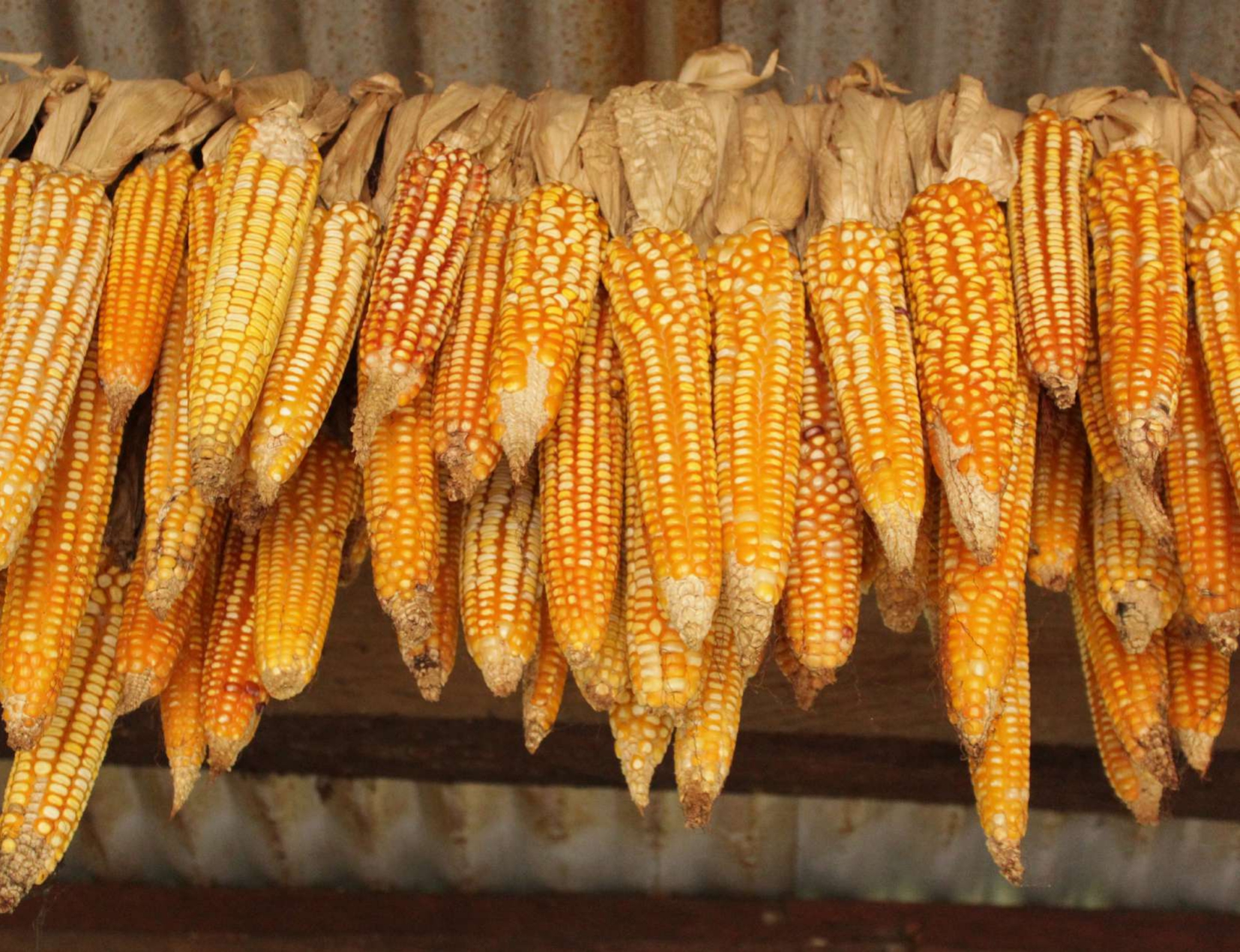Phenological and morphological characterization of local maize from the municipality of Villaflores- Chiapas, Mexico
DOI:
https://doi.org/10.54502/msuceva.v3n2a5Palabras clave:
Biomass, growth, typologies, Zea mays L., varietiesResumen
Local maize varieties in Mexico play a crucial role in food security, cultural diversity, and agricultural sustainability. These varieties constitute a reservoir of genetic diversity critical for the adaptability of maize to changing climatic conditions. To characterize 12 local maize varieties from the Frailesca Region, Chiapas, an experiment was established under completely randomized field conditions. Evaluated variables included phenological cycle, leaf and root biomass production, plant height, stem diameter, ear shape, and leaf coloration. A Hierarchical Cluster Multivariate Analysis was conducted to group varieties based on their characteristics. A mixed correlation model was used to assess the dynamic proportion of root biomass to total biomass. Two groups were identified based on phenological characteristics: the first type grouped 10 varieties with early traits, and the second type comprised 2 late varieties. Regarding biomass production, three types were found: high biomass production, with 4 varieties; low biomass production, represented by 7 varieties; and one atypically high biomass production variety. Radical biomass increased linearly until 120 days. The variety "Olotillo Amarillo Parral Dos" achieved greater height, while "Macho Totomoxtle Morado" was the smallest. Ear shapes varied between open and semi-open, and the leaf color was an intense green.
Descargas
Métricas
Citas
Caballero-García MA, Córdova-Téllez L, López- Herrera A de J. Validación empírica de la teoría multicéntrica del origen y diversidad del maíz en México. Revista Fitotecnia Mexicana 2019; 42:357–66. https://doi.org/10.35196/rfm.2019.4.357-366 DOI: https://doi.org/10.35196/rfm.2019.4.357-366
Peretti L. El origen del maíz en relación a los dos géneros y la creación de la tierra fértil en el mito de Tlaltecuhtli. INDIANA - Estudios Antropológicos Sobre América Latina y El Caribe 2020;31:7–31. https://doi.org/10.18441/ind.v37i1.7-31
Rivas RD. El maíz, fuente de cultura mesoamericana. Revista de Museología “Kóot” 2021:44–53. https://doi.org/10.5377/koot.v0i11.10737 DOI: https://doi.org/10.5377/koot.v0i11.10737
Dehouve D. Simbolismo de las técnicas de preparación del maíz. Análisis de unos platillos tlapanecos (me’phaa) del estado de Guerrero (México). Itinerarios 2019:97–118. https://www.ceeol.com/search/article-detail?id=961621 DOI: https://doi.org/10.7311/ITINERARIOS.29.2019.04
Pedroza Ortega LO. Alimento ancestral y de subsistencia: discurso y control del cultivo y consumo de maíz en México, 1937-1961. Historia Y Memoria 2023:135–75. https://doi.org/10.19053/20275137.n27.2023.14812 DOI: https://doi.org/10.19053/20275137.n27.2023.14812
Reyes-Muro L, Camacho-Villa T, Guevara-Hernández F. Rastrojos: manejo, uso y mercado en el centro y sur de México. Pabellón de Arteaga, Aguascalientes, México: 2013
Mitidieri M, Corbino G. Manual de horticultura periurbana. México DF, México: 2012
Quintero JA, Moncada J, Cardona CA. Techno-economic analysis of bioethanol production from lignocellulosic residues in Colombia: A process simulation approach. Bioresour Technol 2013;139:300–7. https://doi.org/10.1016/j.biortech.2013.04.048 DOI: https://doi.org/10.1016/j.biortech.2013.04.048
Del Angel- Pérez AL, Villagómez- Cortés JA, Larqué- Saavedra BS, Adame-García J, Tapia-Naranjo CA, Sangerman-Jarquin DMa, et al. Preferencias y percepciones asociadas con semilla mejorada de maíz según productores de Veracruz Central, México. Rev Mex De Cienc Agric 2018;9:163–73. https://doi.org/10.29312/remexca.v9i1.856 DOI: https://doi.org/10.29312/remexca.v9i1.856
Hernández-Ramos MA, Guevara-Hernández F, Basterrechea-Bermejo JL, Coutiño-Estrada B, La O-Arias MA, Pinto-Ruiz R. Diversidad y conservación de maíces locales de la Frailesca-Chiapas, México. Revista Fitotecnia Mexicana 2020; 43:471. https://doi.org/10.35196/rfm.2020.4.471 DOI: https://doi.org/10.35196/rfm.2020.4.471
Guevara-Hernández F, Hernández-Ramos M, La O-Arias M, Pinto-Ruíz R, Rodríguez-Larramendi L, Raj Aryal D. Physical-chemical characterization of local maize from Chiapas, Mexico. Revista de La Facultad de Agronomía, Universidad Del Zulia 2022;39:e223924. https://doi.org/10.47280/RevFacAgron(LUZ).v39.n2.02 DOI: https://doi.org/10.47280/RevFacAgron(LUZ).v39.n2.02
Fonseca Flores MD los A, Guevara F, García A, Márquez C, Parra M. Diversity of local maize in ejidos of the Frailesca Region of Chiapas, Mexico. Tropical and Subtropical Agroecosystems 2023;26. https://doi.org/10.56369/tsaes.4397 DOI: https://doi.org/10.56369/tsaes.4397
Hernández-Ramos MA, Rodríguez-Larramendi LA, Guevara-Hernández F, Rosales-Esquianca MD los Á, Pinto-Ruiz R, Ortiz-Pérez R. Caracterización molecular de maíces locales de la Reserva de la Biosfera La Sepultura, México. Agronomía Mesoamericana 2016;28:69. https://doi.org/10.15517/am.v28i1.21612 DOI: https://doi.org/10.15517/am.v28i1.21612
Arias-Yero L, Guevara-Hernández F, La O-Arias MA, Cadena-Iñiguez P. Caracterización y tipos de familias productoras de maíz local en la Frailesca, Chiapas. CienciaUAT 2022:155–71. https://doi.org/10.29059/cienciauat.v16i2.1525 DOI: https://doi.org/10.29059/cienciauat.v16i2.1525
Guevara-Hernández F, Hernández-Ramos M, Ortíz-Pérez-RH, Acosta-Roca R. Maíces locales de la Frailesca Chiapaneca: Diversidad, usos múltiples y distribución. 1st ed. México DF, México: Ediciones Inca y Unidad de Divulgación Científica-UNACH-UNICACH-Red de Estudios para el Desarrollo Rural A.C.; 2021.
Instituto Nacional de Estadística y Geografía-INEGI. Mapas climatológicos. Geografía (INEGI) 2022. https://www.inegi.org.mx/temas/climatologia/
StatSoft INC. Statistica (Data Analysis Software System) 2014.
Hernández Rodríguez C, Ojeda Quintana L, Arteaga Rodríguez O, Sánchez Cordero L. Emergencia y desarrollo del maíz (Zea mays L.) en un suelo contaminado con Hidrocarburos Totales del Petróleo en fase inicial y a 340 días de biorremediación en biopilas. Revista Científica Agrosistemas 2019;7:94–102. https://aes.ucf.edu.cu/index.php/aes/article/view/297/323
Badu-Apraku B, Fakorede MAB. Morphology and physiology of maize. advances in genetic enhancement of early and extra-early maize for Sub-Saharan Africa, Cham: Springer International Publishing; 2017, p. 33–53. https://doi.org/10.1007/978-3-319-64852-1_3 DOI: https://doi.org/10.1007/978-3-319-64852-1_3
Andrade F, Andrade J, Bonelli L, Borrás L, Caviglia O, Cerrudo A, et al. Ecofisiología y manejo del cultivo de maíz. 1st ed. MAIZAR, Asociación Maíz y Sorgo Argentino; 2023. https://repositorio.inta.gob.ar/handle/20.500.12123/14738.
Momesso L, Crusciol CAC, Cantarella H, Tanaka KS, Kowalchuk GA, Kuramae EE. Optimizing cover crop and fertilizer timing for high maize yield and nitrogen cycle control. Geoderma 2022;405:115423. https://doi.org/10.1016/j.geoderma.2021.115423 DOI: https://doi.org/10.1016/j.geoderma.2021.115423
García-Mendoza PJ, Pérez-Almeida IB, Prieto-Rosales GP, Medina- Castro DE, Manayay Sánchez D, Marín-Rodríguez CA, et al. Interacción genotipo ambiente y potencial productivo de 25 variedades de maíz amiláceo en la provincia de Tayacaja, Perú. Bioagro 2021; 33:67–78. https://doi.org/10.51372/bioagro332.1 DOI: https://doi.org/10.51372/bioagro332.1
Ponce-Encinas MC, López-Morales F, Chura-Chuquija J, Hernández-Leal E, Hernández-Salinas G, Aragón-García A. Interacción genotipo-ambiente del rendimiento en híbridos de maíz amarillo mediante AMMI y SREG. Rev Mex De Cienc Agric 2022;13:1247–58. https://doi.org/10.29312/remexca.v13i7.3070 DOI: https://doi.org/10.29312/remexca.v13i7.3070
West-Eberhard MJ. Phenotypic Plasticity. Encyclopedia of Ecology, Elsevier; 2008, p. 2701–7. https://doi.org/10.1016/B978-008045405-4.00837-5 DOI: https://doi.org/10.1016/B978-008045405-4.00837-5
Puebla Albiter S, Rebollar-Rebollar S, Astivia-Arellano F. Maize silage and maize stubble, strategy for cattle feed in dry seasons. Agro Productividad 2023. https://doi.org/10.32854/agrop.v15i12.2269 DOI: https://doi.org/10.32854/agrop.v15i12.2269
Hellin J, Erenstein O, Beuchelt T, Camacho C, Flores D. Maize stover use and sustainable crop production in mixed crop–livestock systems in Mexico. Field Crops Res 2013;153:12–21. https://doi.org/10.1016/j.fcr.2013.05.014 DOI: https://doi.org/10.1016/j.fcr.2013.05.014
Guevara-Hernández F, Hernández-Ramos M, Basterrechea-Bermejo J, Pinto-Ruiz R, Venegas-Venegas J, Rodríguez-Larramendi L, et al. Maíces locales; una contextualización de identidad tradicional. Revista de La Facultad de Ciencias Agrarias Universidad Nacional de Cuyo 2019;51:369–81. http://www.scielo.org.ar/pdf/refca/v51n1/v51n1a26.pdf.
Pascual Franco Martínez J, González Huerta A, Pérez López D, González Ronquillo M. Caracterización fenotípica de híbridos y variedades de maíz forrajero en Valles Altos del Estado de México, México. Rev Mex De Cienc Agric 2015;6:1915–27. DOI: https://doi.org/10.29312/remexca.v6i8.529
https://www.scielo.org.mx/pdf/remexca/v6n8/2007-0934-remexca-6-08-01915-en.pdf.
Blanco Y, Afifi M, Swanton C. Efecto de la calidad de la luz en el cultivo del maíz: Una herramienta para el manejo de plantas arvenses. Cultivos Tropicales 2015;36:62–71. http://scielo.sld.cu/pdf/ctr/v36n2/ctr09215.pdf.
Villalobos-González A, López-Hernández MB, Valdivia-González NA, Arcocha-Gómez E, Medina-Méndez J. Variabilidad genética de características morfológicas de maiz nativo (Zea mays L.) en la Península de Yucatán, México. Agro Productividad 2019;12.
https://doi.org/10.32854/agrop.vi0.1486 DOI: https://doi.org/10.32854/agrop.vi0.1486

Descargas
Publicado
Cómo citar
Número
Sección
Licencia
Derechos de autor 2023 Llaven-Martínez et al.

Esta obra está bajo una licencia internacional Creative Commons Atribución-NoComercial-SinDerivadas 4.0.
Magna Scientia UCEVA proporciona un acceso abierto, libre y gratuito a su contenido, basado en el principio de que ofrecer al público un acceso libre a las investigaciones, ayuda a un mayor intercambio global del conocimiento. Lo cual, implica que los usuarios pueden leer, descargar, almacenar, imprimir, buscar, indexar y realizar enlaces a los textos completos de esta revista. Se permite distribuir los diversos artículos en las versiones post-print y oficial, sin previo permiso del autor o editor, considerando que el fin de este, no implica fines comerciales, ni la generación de obras derivadas; Solo se solicita la mención de la fuente así como la autoría. El titular del copyright será el o los autores que publiquen en Magna Scientia UCEVA.
Magna Scientia UCEVA está distribuida bajo los términos de la licencia https://creativecommons.org/licenses/by-nc-nd/4.0/deed.es



















